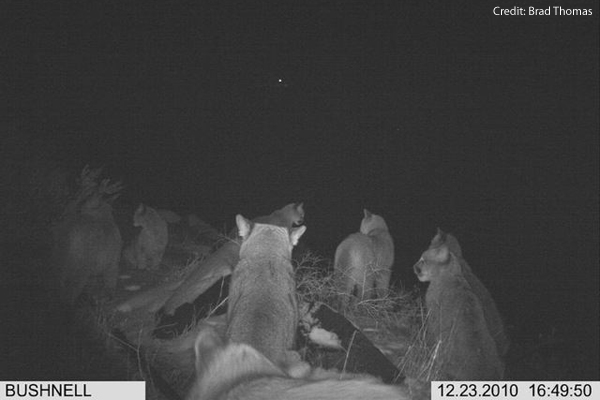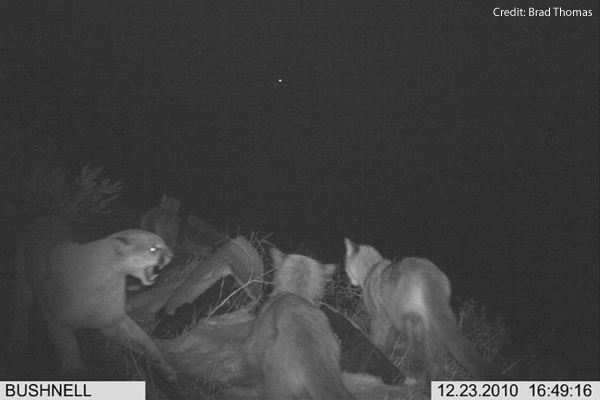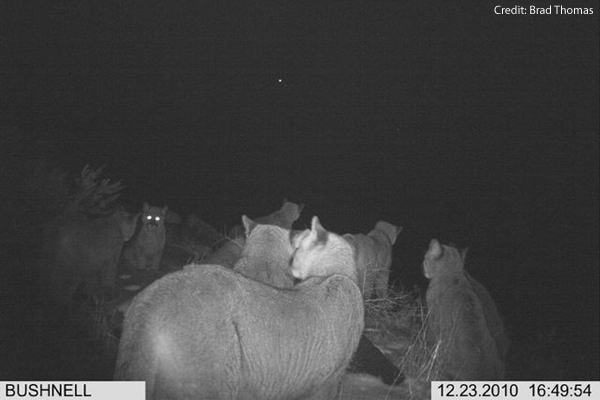Rare Cougar Family Reunion Caught On Camera

Whether you call them cougars, panthers, mountain lions or pumas, you can usually leave off the "s." These elusive cats almost always fly solo. They silently stalk their prey through the woods, then, when the moment is right, pounce — aiming for the jugular. As one of the few wild predators in the United States capable of killing humans, their stealth and prowess can be chill-inducing for hikers.
But what's scarier than a lone, stalking cougar? Perhaps a hungry cougar pack.
Shocking new photos, taken with a night camera by a hunter in Wenatchee, Wash., show eight of the predators crowded around a cow carcass. Officials at the Washington Department of Fish and Wildlife say the scene is extremely rare. Why might they have gathered?
"The only [possible explanation] is that this is a mom and her kittens, and her daughter (from a previous litter) and her daughter's kittens," Fish and Wildlife cougar specialist Rich Beausoleil told Life's Little Mysteries, a sister site to LiveScience.
Robert Wielgus, a biologist at Washington State University who has studied the state's cougars for 37 years, believes the photos do indeed show the rare reunion of an extended family group.
"Typically, there will be one female home range next to another, and they will visit each other from time to time," Wielgus told Life's Little Mysteries. "One female will bring her kids to visit 'Grandma' or Aunty So-and-So.'"

Gathering for dinner
Sign up for the Live Science daily newsletter now
Get the world’s most fascinating discoveries delivered straight to your inbox.
Brad Thomas, the Wenatchee-based hunter whose night camera snapped these photos in December, happened to record just such a family reunion. The event has not been reported by national media and made its way to our inbox just this week.
"What happened here is you've got a bunch of meat on the border of two territories of related females," Wielgus said. A female puma's territory is about 150 square miles (400 square km) large. "They might be sisters or a mother and daughter, and each one has got a family — those are almost-grown cubs that are about 1.5 years old." Two mothers with three teenage cubs apiece all add up to the eight cougars shown in the photo, he said.
One photo shows a cougar growling at another. "There will be some squabbling. Just like in any family, some people want more than their fair share of the turkey or stuffing. But for the most part they behave much nicer towards each other than they do to strangers," Wielgus explained. "This would never happen if they were unrelated."
Strangers aren't invited to the party, and neither are adult males, he said. Male cougars patrol larger areas than females and typically mate with two or three of them. They have minimal contact with their cubs, serving them only in a paws-off capacity by keeping other adult males away.

Should we worry?
Are cougar packs a cause for concern for people who live in rural places? Wielgus says definitely not. In fact, in his opinion, humans need not even fear solitary cougars.
"In the recorded history of Washington State there was one cougar attack. It practically never happens. You're going to be attacked by a deer before you're attacked by a cougar. Deer attacks are more common. Lightning strikes are even more common. The probability is infinitesimally small."
Nationwide, 88 cougar attacks occurred between 1890 and 2004. Human encroachment on their habitat has driven up the frequency in recent years, with a dozen attacks happening in California alone between 1986 and 2006.
This article was provided by Life's Little Mysteries, a sister site to LiveScience. Follow Natalie Wolchover on Twitter @nattyover
Natalie Wolchover was a staff writer for Live Science from 2010 to 2012 and is currently a senior physics writer and editor for Quanta Magazine. She holds a bachelor's degree in physics from Tufts University and has studied physics at the University of California, Berkeley. Along with the staff of Quanta, Wolchover won the 2022 Pulitzer Prize for explanatory writing for her work on the building of the James Webb Space Telescope. Her work has also appeared in the The Best American Science and Nature Writing and The Best Writing on Mathematics, Nature, The New Yorker and Popular Science. She was the 2016 winner of the Evert Clark/Seth Payne Award, an annual prize for young science journalists, as well as the winner of the 2017 Science Communication Award for the American Institute of Physics.










